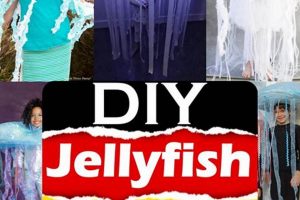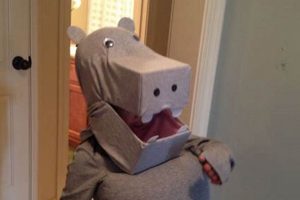The construction of a homemade clown outfit with minimal preparation time is a popular pursuit, often undertaken when a spontaneous need for such attire arises. This endeavor typically involves repurposing existing clothing items and utilizing readily available craft materials to quickly assemble a recognizable clown aesthetic. An example would be transforming an oversized t-shirt and colorful leggings, coupled with face paint, into a presentable, albeit quickly made, clown disguise.
The appeal of generating such an outfit lies in its affordability and adaptability. It provides a cost-effective solution for parties, theatrical events, or playful activities where a pre-fabricated costume is not desired or readily available. Historically, individuals have improvised costumes for various celebrations, reflecting resourcefulness and creativity in times of need. This approach allows for personalized expression and often results in unique and memorable ensembles.
The following sections will detail strategies for effective and efficient costume creation, focusing on makeup techniques, clothing modifications, and accessory construction, all geared towards a prompt and successful outcome.
Expedient Clown Attire Construction Strategies
The following guidelines provide actionable strategies for assembling clown-themed apparel from readily available resources with minimal lead time.
Tip 1: Emphasize Oversized Garments: Select articles of clothing significantly larger than the intended wearer. This exaggeration contributes to the classic clown silhouette. Examples include an extra-large button-down shirt or voluminous pants.
Tip 2: Incorporate Bright, Contrasting Colors: Opt for vibrant and clashing colors to maximize visual impact. Pair primary hues like red, blue, and yellow or consider contrasting patterns such as polka dots and stripes.
Tip 3: Utilize Face Paint Strategically: Apply bold, simple designs using non-toxic face paint. Focus on exaggerating facial features, such as enlarged eyebrows, a prominent red nose, and a wide, exaggerated smile.
Tip 4: Repurpose Everyday Accessories: Transform ordinary items into clown-appropriate accessories. A colorful shower cap can become a comical wig, while mismatched socks can serve as hand coverings.
Tip 5: Craft an Oversized Bow Tie: Construct a large bow tie using fabric scraps, cardboard, or paper. Secure it to the collar of the shirt using safety pins or adhesive tape.
Tip 6: Modify Footwear for Emphasis: Utilize large, ill-fitting shoes or boots. Stuff the toes with paper to create a bulbous shape. Alternatively, affix colored pom-poms or bells to the shoes for added flair.
Tip 7: Prioritize Simplicity and Speed: Refrain from attempting complex or time-consuming techniques. Focus on achieving a recognizable clown aesthetic through basic alterations and readily available materials.
Adhering to these guidelines will enable the rapid and effective creation of a clown costume using commonly available resources. The emphasis remains on simplicity, visual impact, and efficient utilization of time and materials.
The subsequent section will address makeup application techniques for achieving a distinctive and memorable clown persona.
1. Resourcefulness
Resourcefulness serves as a foundational element in the successful creation of a homemade clown costume when time constraints are significant. Its application extends beyond mere cost-effectiveness, encompassing the ability to identify and repurpose existing materials in inventive ways to achieve the desired aesthetic.
- Material Repurposing
Material repurposing involves transforming ordinary items into costume components. For instance, old newspapers can be fashioned into oversized shoes, or discarded fabric scraps can be assembled into a patchwork vest. This facet underscores the capacity to see potential in seemingly unusable materials and adapt them creatively. In the context of a time-sensitive project, material repurposing circumvents the need for sourcing new supplies, saving both time and money.
- Adaptable Skills Application
Adaptable skills application refers to leveraging existing skills in tailoring, crafting, or painting to modify or enhance costume elements. A rudimentary knowledge of sewing, for example, allows for quick alterations to clothing, while basic painting skills facilitate the creation of face paint designs or decorative accents. The ability to apply these skills flexibly accelerates the costume construction process.
- Inventory Assessment and Utilization
Inventory assessment involves a thorough evaluation of available resources, including clothing, accessories, and craft supplies, to identify items suitable for incorporation into the costume. This process often reveals unexpected possibilities, such as using a brightly colored beach ball as a makeshift wig base or repurposing a shower curtain as a waterproof cape. Effective inventory assessment minimizes reliance on external acquisitions and promotes the efficient use of pre-existing materials.
- Innovative Problem-Solving
Innovative problem-solving is the capacity to overcome challenges through unconventional methods. Faced with a missing component, such as a red nose, resourcefulness dictates the creation of a substitute using available materials, perhaps molding clay or shaping cardboard. The aptitude for creative problem-solving is essential when improvising a costume with limited time and resources.
The resourceful approach enables the rapid assembly of a presentable clown costume using readily available materials and skills. It prioritizes ingenuity and adaptability, compensating for the absence of specialized resources or extended preparation time, and it exemplifies the core attributes needed to produce a “last minute diy clown costume”.
2. Adaptability
Adaptability forms a cornerstone of effective creation within the framework of quickly-assembled clown costumes. The intrinsic nature of a last-minute project necessitates the capacity to modify plans, repurpose materials in unforeseen ways, and improvise solutions when ideal resources are unavailable. A lack of adaptability directly impacts the feasibility of producing a satisfactory costume within the allotted timeframe, often resulting in incomplete or substandard outcomes. For example, should a planned fabric for a clown collar prove unavailable, a failure to adapt by substituting an alternative material, such as crepe paper or felt, would impede progress and compromise the overall aesthetic.
The importance of adaptability extends beyond material substitutions. It also encompasses the modification of design elements based on the available resources. If intricate makeup designs p
rove too time-consuming, a simplified, more readily achievable design must be implemented. Similarly, complex clothing alterations may need to be abandoned in favor of simpler modifications or the acceptance of existing garment imperfections. The ability to assess limitations and adjust strategies accordingly is crucial. A concrete illustration involves using readily available colored tape to create stripes on plain clothing, bypassing the need for sewing skills or specialized fabric paints. This demonstrates a pragmatic adjustment to resource constraints, preserving the intended visual effect through alternative means.
In summary, adaptability is not merely a desirable attribute but an indispensable requirement for successfully executing a clown costume construction project under stringent time constraints. Its integration ensures the flexible navigation of resource limitations and facilitates the achievement of a presentable outcome, despite the inherent challenges of a last-minute endeavor. The ability to modify plans and creatively repurpose materials allows the transformation of constraints into opportunities, ultimately defining the success or failure of the project.
3. Exaggeration
Exaggeration constitutes a core design principle in clown costumery, and its role is amplified when constructing an outfit with minimal preparation time. The inherent aim of a clown persona is to amplify characteristics, whether through oversized clothing, pronounced makeup, or boisterous accessories. In the context of a rushed project, exaggeration provides a crucial shortcut. Rather than striving for meticulous detail or perfect fit, the focus shifts to amplifying existing features or creating deliberately exaggerated elements. A standard-sized hat, for instance, becomes more clownish through the addition of oversized decorations, such as feathers or pom-poms. The result is an immediate and visually striking effect that compensates for any lack of refinement in construction.
The application of exaggeration extends to makeup. Instead of employing complex shading or blending techniques, a quickly applied, bold makeup design that focuses on enlarging featuressuch as the eyes or mouthbecomes more effective. A real-world example is using stark white face paint overlaid with disproportionately large red circles on the cheeks and an excessively wide, painted smile. Similarly, clothing choices benefit from this principle. An ill-fitting, overly large jacket, even if it lacks sophisticated tailoring, immediately conveys the clown aesthetic. The absence of time for alterations is offset by the intentional emphasis on size and disproportion. Furthermore, accessories, such as oversized bow ties or comically large shoes, reinforce the theme without demanding extensive crafting.
In summary, exaggeration is not merely an aesthetic choice but a pragmatic strategy for creating a clown costume under time constraints. By prioritizing amplified features and deliberately disproportionate elements, the constructor achieves an immediate and recognizable effect. This approach mitigates the need for intricate detailing or perfect execution, rendering it an indispensable component of crafting a clown outfit in a last-minute scenario. The purposeful use of exaggeration allows for a faster and more effective visual outcome than attempting precise replication of a traditional clown costume.
4. Improvisation
Improvisation is intrinsically linked to the creation of a clown costume when time is a critical constraint. The lack of opportunity for meticulous planning and the potential absence of conventional materials necessitate a reliance on spontaneous adaptation and innovative problem-solving. The success of generating such a costume often hinges on the ability to identify alternative uses for available items and to devise unconventional solutions to unforeseen challenges. A concrete example would be utilizing bubble wrap, typically used for packaging, as a textural element to mimic ruffled fabric or an exaggerated collar. Such a choice, born out of necessity, highlights the crucial role of improvisation in compensating for the lack of specialized resources. The absence of readily available clown-specific accessories, such as a pre-made red nose, requires immediate creation using materials at hand, like modeling clay or even a painted ping pong ball attached with an elastic band. These substitutions demonstrate how improvisation directly translates into a functional element of the costume.
The application of improvisation extends beyond material selection to encompass design modifications. A planned costume element, such as a specific pattern or color scheme, may prove unattainable due to limited resources. In such scenarios, the ability to improvise by adapting the design based on available materials becomes paramount. For example, if brightly colored fabric is unavailable, the costume creator might utilize black and white clothing, adding splashes of color through painted accents or repurposed accessories. This adaptation allows for the preservation of the overall clown aesthetic, despite the lack of ideal materials. Furthermore, the spontaneous incorporation of found objects can lend a unique and unexpected character to the costume. The addition of a brightly colored feather boa found in a drawer, for instance, injects a whimsical element and requires no additional construction time or expense.
In conclusion, improvisation is not merely a supplementary skill but an essential prerequisite for generating a clown costume under severe time constraints. Its application directly influences the feasibility and quality of the final product. The ability to adapt, innovate, and spontaneously solve problems allows the transformation of limitations into opportunities, resulting in a unique and often surprisingly effective costume. The direct connection between improvisation and resourcefulness enables a presentable outcome, even when conventional resources or preparation time are lacking, thus exemplifying the spirit of a “last minute diy clown costume.”
5. Simplicity
The principle of simplicity is paramount in the context of crafting a “last minute diy clown costume.” Time constraints inherently limit the feasibility of complex designs or elaborate construction techniques. Therefore, a direct inverse relationship exists between the available time and the permissible complexity of the costume. Attempting intricate patterns or detailed embellishments within a short timeframe inevitably leads to compromised results or outright failure. The selection of straightforward design elements and easily executable construction methods becomes a necessity, not merely a stylistic choice. For example, opting for basic shapes in face paint application, such as circles and triangles, rather than attempting detailed character renderings, directly contributes to a quicker and more successful outcome.
The practical significance of embracing simplicity extends beyond mere time management. It also dictates the resourcefulness employed in material selection and construction. Complex designs often necessitate specialized materials or tools, which may not be readily available on short notice. Conversely, simple designs can be effectively realized using commonly available items and basic skills. A simple ruff
led collar can be constructed from crepe paper or gathered fabric scraps, while a more elaborate design might require specialized sewing techniques or expensive materials. The application of simplification further reduces the skill threshold required for successful costume creation. Complicated sewing, painting, or crafting techniques are replaced with more accessible alternatives, broadening the potential for individuals with limited experience to achieve a satisfactory result. Examples include using safety pins instead of stitching or employing pre-existing garments with minimal alteration.
In summary, simplicity serves as a foundational element in the successful execution of a “last minute diy clown costume.” It mitigates the challenges posed by limited time and resources, fostering a realistic and achievable objective. By prioritizing straightforward designs, readily available materials, and easily applicable techniques, the principle of simplicity maximizes the probability of creating a presentable and recognizable clown costume within the given constraints. The application of this principle transcends mere aesthetic considerations; it becomes a fundamental determinant of the project’s feasibility and overall success.
6. Colorfulness
The strategic deployment of color holds significant weight in the creation of a clown costume, particularly when time is limited. Colorfulness serves as a readily achievable substitute for intricate design or complex construction. Its immediate visual impact allows for a recognizable clown aesthetic to be established quickly and efficiently.
- Primary Hue Dominance
The utilization of primary colors, such as red, blue, and yellow, is a direct and effective method for achieving visual impact. These hues possess inherent vibrancy and are readily identifiable, instantly signaling a clown-like appearance. A prime example involves pairing a red shirt with blue pants and yellow shoes, achieving a recognizable theme without requiring extensive tailoring or design skills. The strategic use of primary hues serves as a rapid and impactful design choice.
- Contrasting Color Combinations
The juxtaposition of contrasting colors enhances visual interest and contributes to the overall exaggerated effect. Pairing complementary colors, such as orange and blue or green and red, creates immediate visual tension, a hallmark of clown aesthetics. This effect can be readily achieved by combining mismatched socks, gloves, or accessories in contrasting shades. The deliberate application of clashing colors amplifies the comical nature of the costume and requires minimal effort.
- Patterned Fabrics Integration
Incorporating patterned fabrics, such as polka dots, stripes, or checks, adds depth and visual complexity to the costume. These patterns are intrinsically playful and contribute to the overall whimsical aesthetic. An example would be the utilization of a polka-dotted scarf or a striped pair of pants. The incorporation of these fabric patterns provides a visually stimulating element to the overall outfit.
- Accessory Color Coordination
The strategic use of color-coordinated accessories can effectively tie the entire costume together. Employing brightly colored hats, oversized bow ties, or clown noses that complement the clothing creates a cohesive and visually appealing ensemble. For instance, a brightly colored wig matched with a corresponding bow tie enhances the overall visual impact of the costume and requires minimal construction effort. The deliberate arrangement of accessories in a color-coordinated scheme elevates the overall aesthetic and contributes to a cohesive design.
These facets underscore the pivotal role of color in rapidly creating a visually engaging clown costume. The application of primary hues, contrasting color combinations, patterned fabrics, and coordinated accessories provides an efficient means of achieving a recognizable clown aesthetic with minimal investment of time and effort. This approach emphasizes the significance of strategic color deployment as a cornerstone of successful “last minute diy clown costume” creation.
7. Availability
The core concept of a spontaneously generated clown costume is intrinsically linked to the immediate availability of resources. The phrase “last minute” dictates that conventional procurement channels are bypassed, compelling the costume’s construction solely from elements readily accessible at the moment of need. This constraint elevates availability from a mere convenience to a fundamental prerequisite. The feasibility of creating a presentable outfit hinges entirely on what is immediately at hand, shaping design choices, material selections, and the overall complexity of the final product. For example, if face paint is unavailable, the construction will require finding alternative methods to achieve a clown-like facial appearance; this might be accomplished by using household items like eyeliner or lipstick, or altogether bypassing facial decoration.
The emphasis on resource availability causes a direct shift in creation approach. Traditional costume design often prioritizes aesthetic vision and the sourcing of specific materials to fulfill that vision. In contrast, the “last minute” context necessitates a pragmatic evaluation of existing resources and the adaptation of the costume design to accommodate them. The process becomes one of improvisational assembly, utilizing whatever clothing, accessories, and craft supplies are immediately accessible. A brightly colored shower curtain, typically intended for bathroom use, might be repurposed as a clown cape due to its availability and vibrant hue. This adaption highlights how availability functions as a catalyst for unconventional problem-solving and innovative material repurposing, shaping the final form of the costume.
In conclusion, availability is not simply a contextual factor but a defining characteristic of a spontaneously assembled clown costume. Its impact spans the entire creation process, influencing design choices, material selections, and the overall aesthetic. Understanding the primacy of resource availability enables a more realistic and adaptable approach to costume creation, mitigating the challenges of limited time and external sourcing options. The inherent limitations imposed by availability simultaneously serve as a catalyst for ingenuity, forcing the resourceful utilization of existing materials and fostering a unique approach to costume design.
Frequently Asked Questions
The following section addresses common inquiries regarding the construction of a clown costume under severe time constraints, emphasizing practicality and resourcefulness.
Question 1: What constitutes a true “last minute” costume creation scenario?
A “last minute” scenario typically involves a window of opportunity ranging from one to three hours preceding the event necessitating the costume. This timeframe inherently limits the scope of potential construction methods and material acquisition.
Question 2: Is specialized knowledge required to construct such a costume?
Specialized knowledge is not a prerequisite. Success hinges on resourcefulness, creativity, and the ability to adapt readily available materials. Basic crafting skills are beneficial but not essential.
Question 3: What are the most common
pitfalls to avoid?
Common pitfalls include attempting overly complex designs, underestimating the time required for specific tasks, and failing to adequately assess available resources before commencing construction.
Question 4: Can a presentable clown costume be created without purchasing any new materials?
Yes, a presentable costume can often be constructed using existing clothing items, household materials, and basic craft supplies. The emphasis should be placed on repurposing and adapting existing resources.
Question 5: What makeup techniques are most effective in a time-constrained environment?
Effective makeup techniques prioritize bold, simple designs. Focus on exaggerating key facial features, such as the eyes, mouth, and nose, using easily applied colors and shapes. Intricate blending or shading techniques should be avoided.
Question 6: What are the essential elements that contribute to a recognizable clown aesthetic?
The essential elements include oversized clothing, bright and contrasting colors, exaggerated facial features, and whimsical accessories. Emphasis should be placed on these core components rather than striving for perfect replication of a traditional clown costume.
In summary, successful “last minute diy clown costume” creation hinges on practicality, resourcefulness, and a willingness to adapt existing materials. Focusing on essential elements and avoiding overly complex designs will maximize the probability of a presentable outcome.
The subsequent section will provide guidance on adapting pre-existing wardrobe items for costume construction.
Conclusion
The preceding exploration has illuminated the critical factors governing the successful creation of a clown costume under severe time constraints. Resourcefulness, adaptability, exaggeration, improvisation, simplicity, colorfulness, and availability emerge as the cornerstones of this endeavor. The effective application of these principles enables the generation of a recognizable and presentable costume, even when specialized resources or extensive preparation are absent.
The capacity to transform readily available materials into a cohesive and visually engaging ensemble underscores the potential for creative problem-solving within constrained environments. While this discussion has focused specifically on clown costumes, the underlying principles can be extrapolated to a wider range of impromptu creative projects. A critical evaluation of available resources, coupled with a flexible and imaginative approach, remains essential for achieving successful outcomes in such situations.







